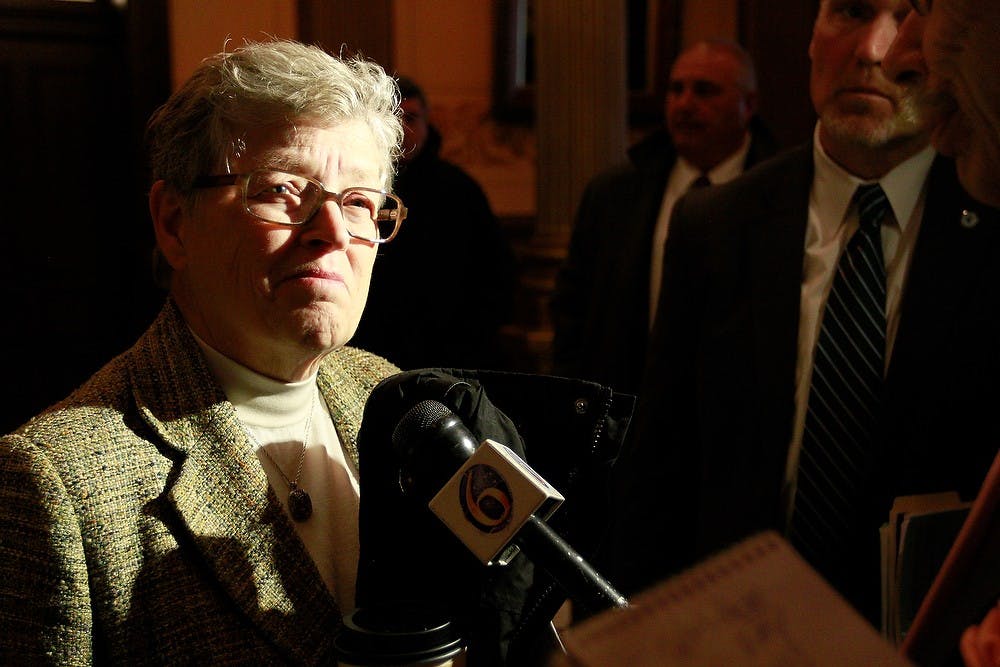MSU President Lou Anna K. Simon testified Tuesday on the proposed budget for the 2015-2016 fiscal term in a joint meeting with both the higher education appropriations subcommittees of both the state Senate and House of Representatives.
“I appreciate that you made the very direct connection between state appropriations and tuition rates ... and that you acknowledge the state’s long-running disinvestment in its public universities,” Simon said.
According to research done by the Detroit-based non-profit Business Leaders for Michigan, among states Michigan had the 5th largest decline in higher education funding from 2009 to 2014.
“MSU has worked hard to remain affordable, especially given the challenges we faced regarding state disinvestment over the last 50 years,” Simon said.
Michigan Gov. Rick Snyder’s most recent executive budget recommendation called for MSU to receive approximately $5.2 million more in funding, an increase of 1.9 percent.
This stands in contrast to last year’s larger 6 percent increase, which was bolstered by the state’s rosy budgetary outlook. But now the state is facing down a deficit, and expectations have been curbed.
Although Snyder’s first budget recommendation when he assumed office called for deep cuts in higher education appropriations, and MSU’s funding decreased 15 percent, each year afterward has received 1 to 2 percent increases, with the exception of last year. Still, funding has yet to return to levels before Snyder entered office.
“Even with last year’s appropriations increase, universities have yet to recover from the 15 percent cut the administration made four years ago,” Simon said. “Today Michigan State remains 6.82 percent below the prior funding level.”
The presidents of Lake Superior State University, Michigan Technological University, Northern Michigan University, Oakland University, Saginaw Valley State University, University of Michigan and Western Michigan University also lauded their respective university’s efforts to increase affordability and cut costs in order to justify their state funding.
“Michigan State made $125 million in cuts, modifying or eliminating more than 40 academic programs,” Simon said.
Simon expressed concern about the proposed requirement of limiting tuition increases to 2.8 percent in order to receive the funding increase. It’s unclear if this indicates MSU is looking at larger increases in tuition.
“MSU would be better served by maintaining a tuition cap no lower than last year’s 3.2 percent,” Simon said. “A cap more on the order of last year’s would give Michigan’s public universities the flexibility we need to maintain our quality and value.”
State Sen. Curtis Hertel Jr., D-East Lansing, said the tuition cap needs to be synchronized with the budget in order to be functional.
“I support tuition caps, but at the same time we have to make sure the funding is at a level that tuition caps actually make sense and are possible to universities,” Hertel said. “If you don’t provide enough additional funding as an incentive, then of course universities have to violate the cap.”
East Lansing’s other state legislator, Democratic Rep. Sam Singh, said a tuition cap could help with college affordability.
“Our goal is to try to keep a tuition cap that is reasonable to the institution but most important, making sure that it is affordable to the students,” Singh said.
When asked on how the tuition cap and the funding formula could affect tuition, Simon said it is important to take in consideration the value of the services the university offers while understanding college accessibility.
“We are trying to balance what the students want in terms of the quality of the experience and access to programs and activities with tuition and access,” Simon said. “It’s always a delicate balancing act.”
Simon said one of the solutions is to provide more financial aid, rather than slow increases in tuition.
“We’ve tripled general fund financial aid in 10 years to $120 million,” Simon said. “This year 65 percent of our students get some form of financial aid and 22 percent of undergraduates received Pell Grants in fiscal (year) 2014.”







